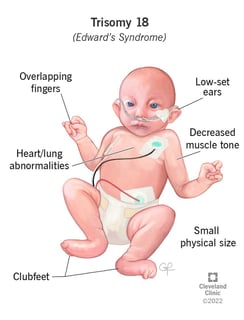Edwards syndrome, also known as trisomy 18, is a genetic disorder caused by the presence of a third copy of all or part of chromosome 18. Many parts of the body are affected. Babies are often born small and have heart defects. Other features include a small head, small jaw, clenched fists with overlapping fingers, and severe intellectual disability. Most cases of Edwards syndrome occur due to problems during the formation of the reproductive cells or during early development. The rate of disease increases with the mother's age. Rarely, cases may be inherited. Occasionally, not all cells have the extra chromosome, known as mosaic trisomy, and symptoms in these cases may be less severe. An ultrasound during pregnancy can increase suspicion for the condition, which can be confirmed by amniocentesis. Treatment is supportive. After having one child with the condition, the risk of having a second is typically around one percent. It is the second-most common condition due to a third chromosome at birth, after Down syndrome. Edwards syndrome occurs in around 1 in 5,000 live births. Many of those affected die before birth. Some studies suggest that more babies that survive to birth are female. Survival beyond a year of life is around 5–10%. It is named after English geneticist John Hilton Edwards, who first described the syndrome in 1960. From Wikipedia





